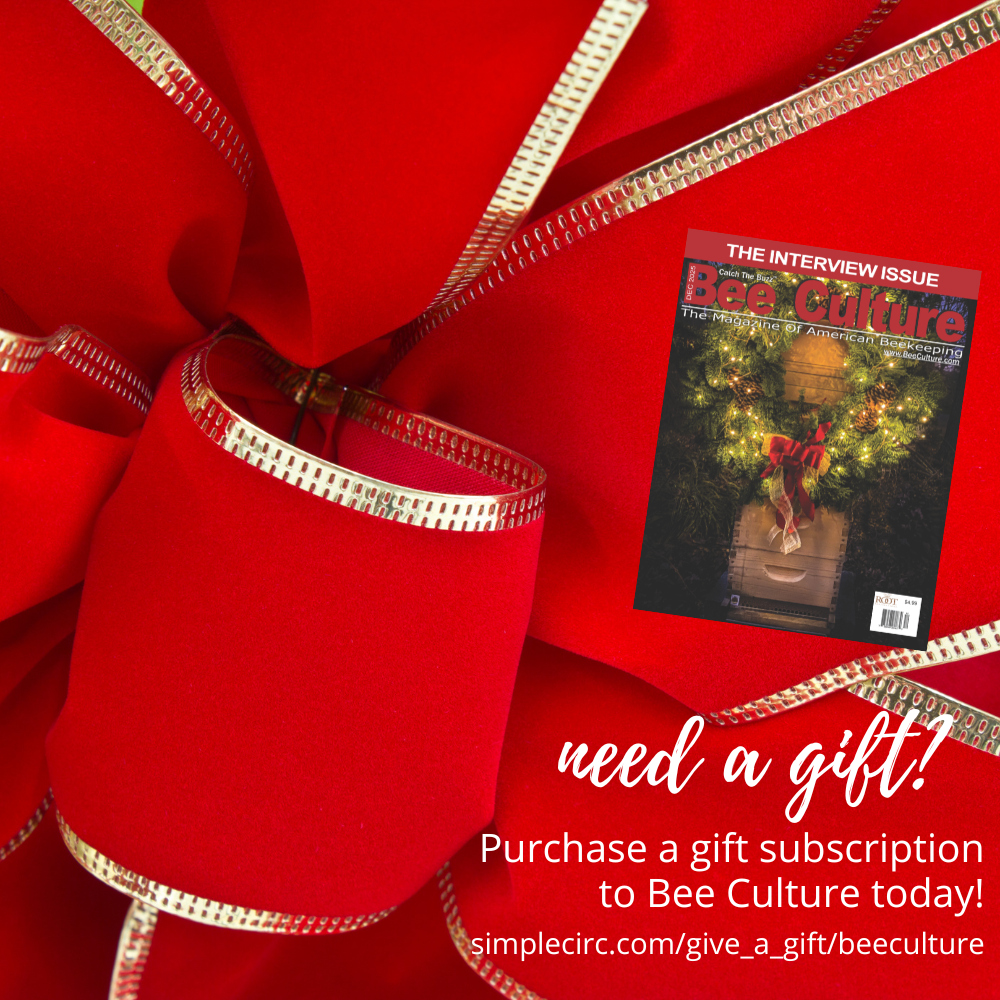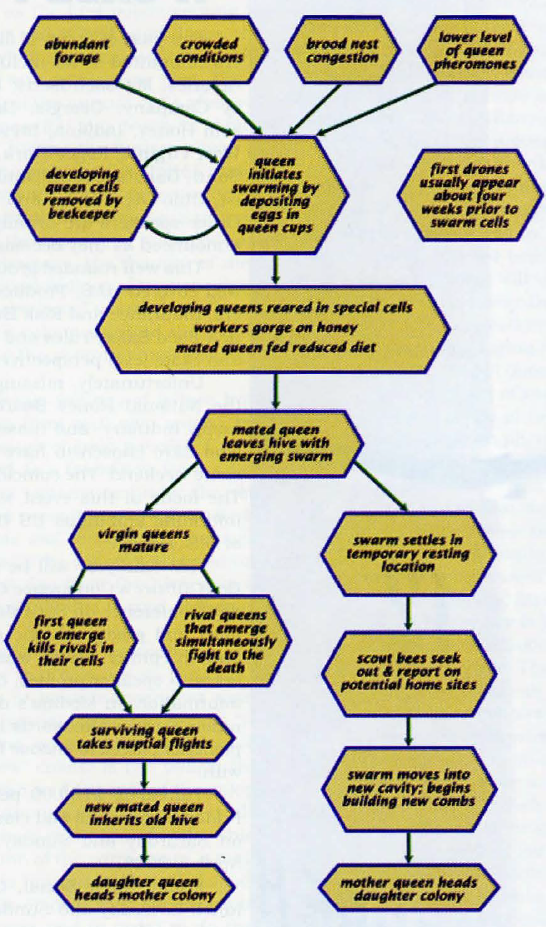By: Steve Repasky
This article originally appeared in the Summer 2016 issue of BEEKeeping Your First Three Years
A Look at the Biology and Mechanics Behind This Fascinating Phenomenon
In temperate areas, beekeepers look forward to many things in the Spring, such as the first pollen coming in from skunk cabbage, crocus, willow and snow drops, the beginning of a nectar flow when the maples bloom or the start of a new hive from a nuc or increase hive. These events herald the beginning of the annual cycle of reproduction for honey bee colonies that may reach its climax only a month or two later. Just as the flowers bloom in the Spring, honey bee colonies across the United States begin preparations for their annual colony reproductive event of swarming. It’s a natural phenomenon; a process that nearly all colonies go through, both managed and unmanaged. For many beekeepers, the thought of their colonies swarming brings mixed feelings of tension, worry and excitement. It causes “new-bees” to switch their concern from making sure their colony survived the Winter to trying not to lose a colony the potential honey harvest and with it.
Losing a swarm may evoke feelings of failure from some beekeepers if it issues from your own apiary, but capturing a swarm is a measure of great success. Catching a swarm is often viewed as a transition from a new beekeeper to one with more experience under the veil. Swarming is exciting and isn’t something to fear; instead, it is something to appreciate and respect. The behavior of a swarm of honey bees, and the colony’s preparations that lead up to a swarm issuing from the hive, give us a wonderful opportunity to study this marvel of Nature.
What is Swarming
Swarming is the colony’s way of reproducing on a large scale. It is a process that colonies go through to divide one colony into two or more independent units, as the season allows. It is asexual, meaning that the “reproduction” occurs by fission, where the colony actually divides in half and the “new” colony is the swarm that leaves with the mother queen and the rest of the colony remains behind to raise a new queen. This process also provides a reduction or a break in the brood cycle, which also may aide in the reduction of the varroa mite, a major pest to the honey bee. It is important that beekeepers understand how to manage or deal with the swarming instinct of honey bee colonies and in order to do that, they must understand the biological processes that take place within the hive.
What Causes Swarming
Various factors contribute to the initiation of swarming behavior in a hive, including the queen’s age, distribution of workers (congestion and colony size), temperature, brood nest availability, pheromone quantity and distribution, and availability of resources – a factor tightly tied to the season and the geographical location of the colony – all influence if and when a colony will swarm. As Spring approaches and the conditions for swarming come together, overwintered colonies will begin their preparations for swarming.
- Dilution of Pheromones A key to understanding the reproductive swarming process is the queen substance, or queen pheromone (QP), produced by the queen and passed along to every member of a hive through food exchange and physical contact. These pheromone levels play an important role in the hives decision to decision to swarm. If a reduction in queen pheromone occurs, this triggers the swarm impulse to begin. Young, newly mated queens have higher pheromone levels pheromones and are less likely to swarm in their first season when compared to older queens in other hives. In older queens, when the levels of queen pheromone declines, the queen is stimulated to deposit eggs into the numerous queen cups found throughout the colony. Because the eggs laid in the cups are fertilized, they are recognized by the colony as future queens and the swarm process begins. How many of these new queen cells are present will assist the colony in potentially issuing afterswarms after the primary swarm departs.
- Congestion As the queen reaches her peak in egg laying (upwards of 1500 or more a day) her level of queen pheromone can be affected by the amount of space available for her to lay in. If she is laying at her peak she produces higher levels of queen pheromone and as space become less available, the level of pheromone produced becomes less. This reduction triggers a genetic mechanism that we call swarming instinct. As laying increases so does the number of bees emerging as adults, the amount of pollen and nectar being stored.
- Genetic Strain The genetic race or strain of the honey bee is a factor in swarming as well. Italians, and Caucasians have a moderate tendency to swarm. These are the bees kept by most beekeepers and can be managed fairly easily with the right know-how. Buckfast bees, which were developed by Brother Adam at the Buckfast Abby and are now are bred in Denmark and propagated in Ontario, have a low tendency to swarm and are known for their gentleness.
On the other end of the spectrum you have Carniolans and USDA Russians (a genetic derivative of Carniolan bees). Camiolans overwinter in smaller clusters but can build up rapidly. They have higher tendencies to swarm than Italians but not as much tendency as the Russian queen families – it has been speculated that swarming is one of the mechanisms of varroa mite tolerance developed when Carniolan stock was introduced into Eastern Russia where the varroa mites are naturally found on their native host, Apis cerana. The effects of isolation in close proximity with varroa mites in Eastern Russia may have included an increased tendency to swarm and create breaks in the brood cycle as a method of colony survival. Russian bees are well known for their tendency to swarm.
- Age of Queen The age of the queen can also play a role in the swarming instinct. Not only do young queens produce a large amount of queen substance (pheromone), young queens also tend to swarm less than older queens (not never). Part of this contrast is due to the reduced pheromone production found in older queens. Manipulating the condition of the queen bee is the primary way many beekeepers influence swarming frequency and timing. As mentioned previously, it bas been shown that younger queens are less likely to produce swarms when all the other space and crowding issues are reduced. Also, the use of a less-likely-to- swarm race or strain of bees will influence swarm production in an apiary. Remember that all strains of honey bees must swarm eventually to produce a new colony, and nearly all will swarm when conditions are favorable, especially when those conditions are related to resource abundance.
The actual process of swarming is quite interesting. Dr. Tom Seeley, in his book Honeybee Democracy, he details the decision making process from early on in the swarm’s development within the hive, the issuing and clustering of the swarm itself, the advertising of selected sites by the returning scouts and final decision making on the new hive location. These worker bees, called scouts, are often older foragers and can number from several dozen to several hundred bees.
Once the swarm issues from a hive, it will cluster on an object nearby, often a limb within 100 meters of the mother hive. The swarm may remain there for several hours and up, to a few days, until a new site is found for the swarm. It is not uncommon for a swarm to move to several temporary locations as new sites are scouted before one is chosen.
A beekeeper may receive a call from a homeowner stating that they have been suddenly overwhelmed by a swarm of bees inside of the living space of the home. This may be the scouting party conducting a site inspection. You, as a beekeeper, may intercept that swarm by placing a swarm trap nearby where it can be discovered by the bees.
A swarm prefers calmer days when the temperatures are warmer and dry. This is typically 75-85 degrees Fahrenheit. Following a weather period that confined them to the hive, bees often swarm on the first day that is sunny and warm with calm or low velocity winds (5 mph or less). The time of day is also an important part of the equation. I’ve noticed that swarms would typically issue from a hive between the hours of eleven o’clock in the morning and two o’clock in the afternoon, though early and late day swarms are not uncommon.
Calendar Timing
Each area of the world where honey bees are kept has its peak swarming seasons. In Florida, the peak swarming activity is in late February and March, while in Pennsylvania it is late May to early June. In Michigan, swarming peaks in late May to early June and in Louisiana it peaks in April, but as in all areas, swarming in these areas is influenced by the season. If there are mild Winter and early Spring conditions, swarming will develop much earlier and last much longer than in a year when the Winter is severe and the foraging delayed. However, the rate of increase in swarming after a severe Winter may be stronger, and still produce abundant swarms if there is adequate forage.
Determining the swarming period using environmental cues can be fairly reliable. In Pennsylvania, we know that we can expect our swarm season to begin approximately four weeks after dandelions begin bloom. This cue is a turning point for most of us to change our management techniques in our own hives to minimize swarming.
A second swarm season develops when late Summer and Fall forage stimulate drone and worker brood production, resulting in later swarms. For example, in 2012 and 2013, I observed heavy swarming in September in Pittsburgh, Pennsylvania.
~Stephen Repasky is an EAS Master Beekeeper and author of Swarm Essentials.











